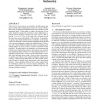Free Online Productivity Tools
i2Speak
i2Symbol
i2OCR
iTex2Img
iWeb2Print
iWeb2Shot
i2Type
iPdf2Split
iPdf2Merge
i2Bopomofo
i2Arabic
i2Style
i2Image
i2PDF
iLatex2Rtf
Sci2ools
110
Voted
MOBIHOC
2005
ACM
2005
ACM
Low-coordination topologies for redundancy in sensor networks
Tiny, low-cost sensor devices are expected to be failure-prone and hence in many realistic deployment scenarios for sensor networks these nodes are deployed in higher than necessary densities to meet operational goals. In this paper we address the question of how nodes should be managed in such dense sensor deployments so that the network topology formed by the active sensors is able to provide connected-coverage to the entire area of interest and at the same time increase the lifetime of the network. In particular, we propose and study distributed, low-coordination node wakeup schemes to efficiently construct multiple independent (node-disjoint) sensor network topologies to achieve good fault tolerance. We propose and evaluate different distributed, random and pattern-based wakeup policies for sensor nodes to construct connected-covered topologies. Through analysis and simulations we demonstrate that in dense sensor deployment scenarios, these policies can construct near-optimal topo...
Dense Sensor Deployments | Individual Sensor Nodes | MOBIHOC 2005 | Sensor Network Topologies | Wireless Networks |
Related Content
| Added | 24 Dec 2009 |
| Updated | 24 Dec 2009 |
| Type | Conference |
| Year | 2005 |
| Where | MOBIHOC |
| Authors | Rajagopal Iyengar, Koushik Kar, Suman Banerjee |
Comments (0)

